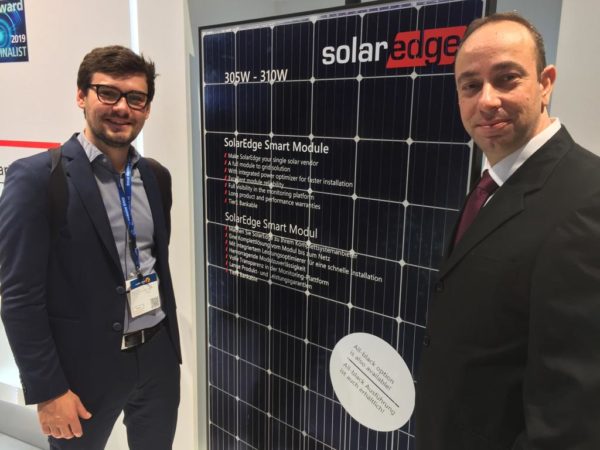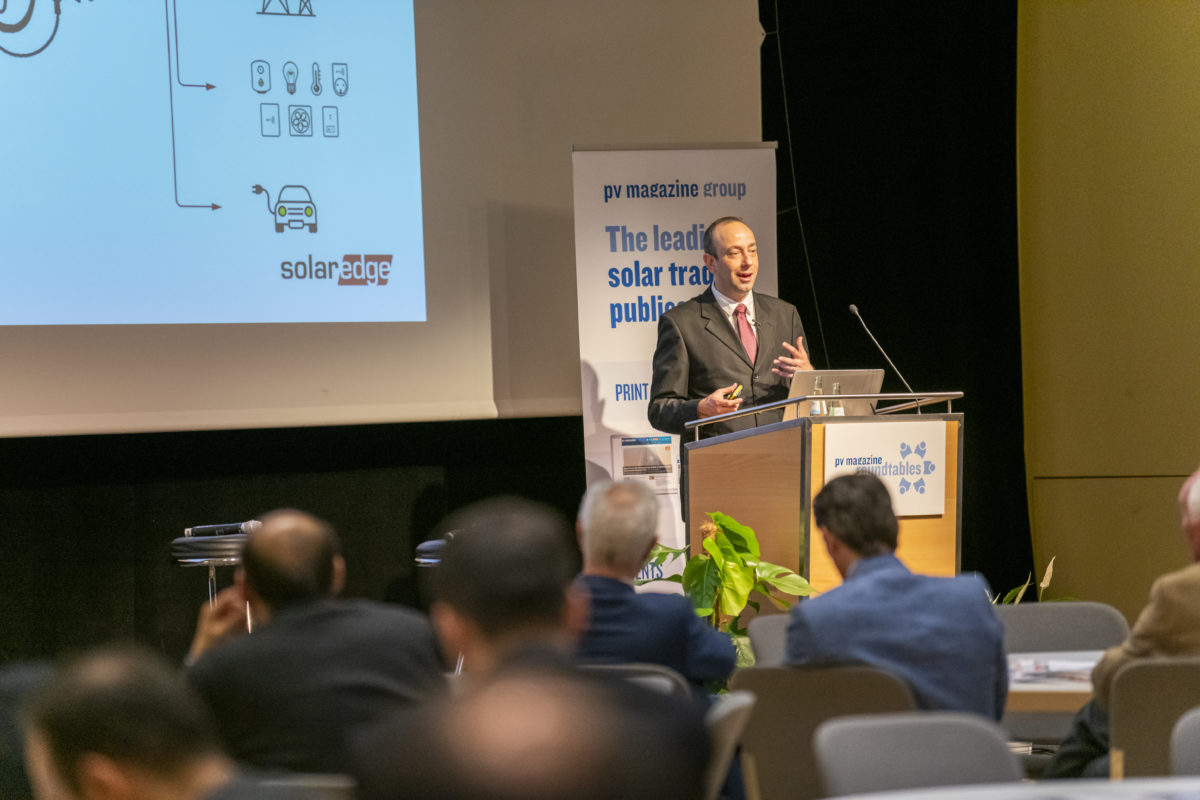pv magazine: We are standing in front of a Solaredge module, Lior what could you tell me about this module?
LH: We get a lot of requests from our customers to provide them with a full solution. They say: ‘We like your inverters, we install the system, can we also get a smart module from you guys that will be more integrated into the Solaredge ecosystem?’ And this is the solution for that. So this is what you see here at the show. This is a 305-310 Wp mono PERC Solaredge module. The module comes with a pre-installed and fully integrated power optimizer and the module is baked into the entire Solaredge ecosystem. So as you install it, mapping the module into the Solaredge monitoring platform is easy. With an external front face barcode. The module as it comes has Solaredge bankability, Tier 1 module supplier bankability. So for customers that want a full solution from Solaredge it is an excellent start.
This is a mono PERC module, will Solaredge offer different module technologies in future?
Yes. So we have started with something that I would say is mid range in terms of market innovation but there is a plan to push up the power capability and to also provide a more premium solution. Some customers want mono PERC; some customers want added power. So yes, we are working on a higher power version also.

Image: pv magazine/ Jonathan Gifford
Apart from the module, Solaredge has also acquired Kokam, a storage system manufacturer. What can you tell me about the strategy behind this acquisition?
So, obviously storage is becoming a very important part of solar. Solar-plus-storage is a big important segment in many European countries, also in some parts of Australia and the U.S. Our inverters can already manage storage, they can provide back-up power and provide maximal self-consumption, time of use and all these necessary applications, and they work with batteries from the industry. We show here that we can work with batteries from LG and BYD. But again, for customers that want, they can get a Solaredge battery. The advantages are faster installation. Everything connects together. There is no need for additional communication cabling, there is one ecosystem. The battery comes from Solaredge. We believe that with the acquisition of Kokam, we can provide very high-end batteries at an affordable price and at a very high quality. These ensure the longevity of the battery and again work much better in the overall Solaredge ecosystem, so for customers that want, we are showing here a residential battery that will be available at the end of the year, or maybe at the beginning of 2020. And a commercial 40 kWh stackable battery that will be available at the end of this year.
And what will be the capacity of the residential battery?
The residential battery will be a 10 kWh battery with 5 kW peak power. You can install several of these batteries in one system if you want higher capacity.
Popular content
For me as a customer what are the advantages of buying from a single supplier my battery, my module, my inverter and my EV charger?
First of all integration. You go onto the Solaredge platform and you see everything in one platform. I’ll just give you one example. With the Solaredge EV charger you now have the ability to better maximize self-consumption because the inverter can also control the EV charger. Unlike the car deciding how much power it will take, we can actually control that and make the car charge faster or slower according to the optimization of the electricity bill. So there is better, tighter integration for better financial return. Better and tighter integration in monitoring and data in one app. You can turn on your Solaredge EV charger, you see the solar system from the Solaredge app, you see the battery from the Solaredge app. And with the EV charger there is the other advantage that you can charge faster than what your grid connection allows. If you have a limited grid connection then we will allow to charge to the maximum from the grid but even increase charging power by tapping into the solar system and battery. Again, a unique selling proposition if you have a system from one vendor. And also, service. If you have an issue, you call Solaredge; you don’t need to talk to two vendors, which is sometimes not a good thing. But sometimes it can happen when you work with multiple vendors.
And is the future of the PV business, this deeper and deeper integration of the different layers of the industry? Will this be the only way to do the inverter business in the future?
I think that it is an important part. We will always support partners; we will always work with other partners. It is a working option but I think for solar systems to become what they need to be, the only or the main power source for us; or fossil fuel to lose the last remaining advantage it is not even price any more, it is the fact that it is central generation which is easier to balance the grid with. So, for systems to become more integrated with the grid: yes, integration is critical.
This content is protected by copyright and may not be reused. If you want to cooperate with us and would like to reuse some of our content, please contact: editors@pv-magazine.com.



By submitting this form you agree to pv magazine using your data for the purposes of publishing your comment.
Your personal data will only be disclosed or otherwise transmitted to third parties for the purposes of spam filtering or if this is necessary for technical maintenance of the website. Any other transfer to third parties will not take place unless this is justified on the basis of applicable data protection regulations or if pv magazine is legally obliged to do so.
You may revoke this consent at any time with effect for the future, in which case your personal data will be deleted immediately. Otherwise, your data will be deleted if pv magazine has processed your request or the purpose of data storage is fulfilled.
Further information on data privacy can be found in our Data Protection Policy.